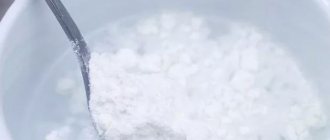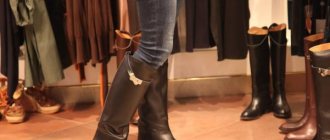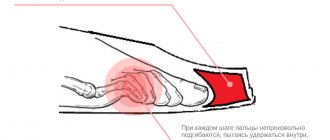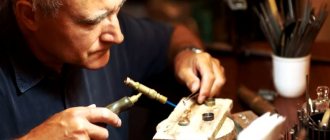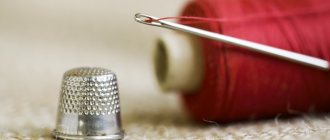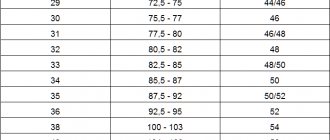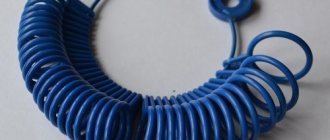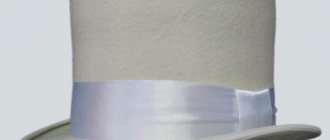Over time or under improper washing conditions, woolen items can decrease in size or, on the contrary, stretch.
This also applies to wool hats. Losing the shape of a wool product is not a reason to throw it away and spend money on a new one.
In this article we will look at what to do if the cap is stretched, what options there are to correct this situation and what is needed for this.
Like any woolen item, a hat can stretch and take on a shapeless, sloppy appearance.
The reasons why this may happen are:
- automatic washing. The knitting of hats is usually weaker than other woolen items and this can cause both shrinkage and stretching of the product. It is advisable to hand wash such items;
- time factor. After some time of wear, the garment may well wear down one or even two sizes;
- improper storage. Some people, after the winter period, in order to maintain the desired shape, pull the hat onto a jar or mannequin, which over time will cause stretching.
The ancestors of modern caps
Modern materials that appeared on the market were adopted by fashion designers. Therefore, the cap has become one of the must-have purchases for fashionistas and fashionistas. Unique and completely new models of caps were developed, intended not only for young people, but also for older citizens.
The modern cap has erased age boundaries and restrictions. She fell in love and became accessible to almost all age categories, without exception. Caps, baseball caps and bonnets are popular among men and women of all ages.
The new cap looks great and pleases its owner with an interesting shape. However, like any item of clothing, after a short time it loses its appearance, gets dirty and urgently requires taking measures that will help restore its original appearance. The ones that need the most care are those worn by children, as well as summer caps. Weather conditions, which can change dramatically in a matter of minutes, can turn a wonderful, perfectly shaped cap into something unattractive.
Having succumbed to the desire to bring the cap back to life, it is important to choose the right method. For example, washing will only make the situation worse.
Reducing the size of the hat so that it fits
The methods depend on the material. You can find out what the hat is made of on the tag.
Woolen
To reduce the size of a knitted wool hat, you will need:
- the hat itself;
- pelvis;
- water;
- ice;
- terry towel;
- wool detergent.
Pour hot water into a basin (temperature 20 degrees higher than indicated on the label) and soak the headdress for half an hour. If there is a special product intended for woolen fabrics, add it in a small amount.
After 30 minutes, the water in the basin will cool down. Now the hat can be gently washed. Do not apply too much force, do not rub or twist it.
Next, drain the water and fill the basin with cold water, you can additionally add ice. Leave for 20 minutes.
Rinse gently. Wrap your hat in a terry towel to remove excess moisture. Leave to dry on a flat horizontal surface.
High temperature leads to compression of the fibers, which causes some shrinkage of the product, while cold water fixes and consolidates the result.
There are two more options for how to reduce the size of a wool hat that has stretched after washing:
- If there is no lining inside, then sew it in. The best option would be to use fleece. The hat will fit tighter on your head and will become even warmer. The product will not stretch during subsequent washes.
- Sew an elastic band along the edge of the hat, about 2-3 cm from the edge. It will help keep the shape, but will not put pressure on your head.
Fur
In this case, downsizing is mainly necessary for the following reasons:
- Deformation.
- We didn't guess the size when purchasing.
But you don’t have such rubber bands, then there are two options left:
- Sew in the hat. The lining fabric is carefully ripped open with a sharp knife or razor. Then you need to rip open the fur trim and the seam on the back that connects all the parts. Then the area required for reduction is removed from both sides. Don't forget to take into account the seam allowance.
- Use additional insulation from batting or padding polyester. You will need to prepare a new lining fabric, since the new piece may not fit under the old material. After removing the old lining, the prepared material is hemmed. A new lining is then sewn on top. This is a labor-intensive option, but it will allow you to further insulate the hat and return it to its original size.
Cotton
Cotton changes shape very well, making it quite easy to size down.
You can iron it with an iron at maximum temperature using the steam function, or use the washing option, similar to wool.
Synthetic
To make a hat made of synthetic fabric shrink, you can wash it in a washing machine at a temperature 10 degrees higher than indicated on the tag, using a spin cycle at maximum speed.
Acrylic
Unfortunately, it is almost impossible for stretched acrylic items to return to their previous appearance, so it would be more advisable to replace the item with a new one.
Felt
Felt is a very finicky material, and after washing its texture becomes rough and hard. You can make a hat or cap made of this material smaller using a thread, a needle and foam tape. You can also use batting or padding polyester.
The outer seam of the tape, which is located at the border of the brim and the crown, needs to be unscrewed. Next, you should insert a foam ring around the circumference of the hat, and then sew up the seam.
Denim
If you wash a stretched denim hat in a machine at a temperature of 80-90 degrees, it will become smaller.
If hand washing, soak the hat for 30 minutes in cold water and then place in boiling water. When the water has cooled, the headdress should be transferred again to cold water and rinsed.
You can dry it on a radiator, in an electric dryer or in a washing machine.
How to reduce the bulk of a felt hat
Finding the best hat for yourself is not so easy.
Sometimes everything fits perfectly: color, cut, style - and it’s impossible to resist buying. But the size is a little too big - and the entire expected effect from the model comes to nothing.
Unfortunately, it will not be possible to reduce more than a few sizes even in a special workshop, but you can reduce a felt hat the way professionals do it by half a size or a size even at home.
How to make a felt hat smaller at home
First, let's remember the properties of the material - this is dense, high-quality wool that has undergone special processing under production conditions. Take a look at the label: it is clearly not recommended to heat treat it, much less wash it. Even more, in such models it is not recommended to be exposed to any precipitation - snow or rain.
So you won’t be able to shrink a felt hat the way you would with a regular woolen item. By soaking it in warm water and drying it even in the most delicate way, you risk losing the shape of the model forever. You should also forget about the possibility of ironing the model with steam - as a result, you can only spoil the texture of the material.
The material is quite capricious, and instead of a silky and plastic texture after such an operation, you risk getting a texture that is rough to the touch and hard.
You should also forget about the method that works great with knitted hats: hold it over steam and let it dry, giving it the desired shape. The felt from such a procedure stretches perfectly, and you risk getting a completely unexpected and unwanted result.
First of all, the size itself reflects the literal circumference of the head. In different measurement systems it is calculated in inches or centimeters.
But the system is quite simple, for example, the Russian “56” corresponds to the international S. it exactly corresponds to a head circumference of 56 centimeters or 22 inches.
In English or American standards, this is size 7, but the difference or step is easiest to calculate in centimeters.
So, we will need: matching threads, a needle and a tailor's seam ripper - you can buy it at any craft store.
You will also need a foam rubber strip, no more than 0.5-0.7 centimeters wide, and no more than 60 centimeters long.
Instead of foam rubber, you can take any light and plastic material, for example, roll a piece of wool into a rope, giving it the desired shape. But as practice shows, foam rubber is more convenient.
Then carefully manually restore the ripped seam - this is what you will need for thread and a needle. A blind or “back needle” stitch with a minimal stitch pitch will not leave a mark on the outer surface of the model.
Do not use an iron under any circumstances. This is the way to reduce a hat by size, suitable for both models with narrow and wide brims.
Quite often the question arises: “how to reduce the volume of a hat?” Not only the size, but also the crown, and sometimes the brim. It is their dimensions that influence not only the correct “fit” but also the overall impression. As you know, the width of the brim and the height of the crown are a matter of personal choice.
Thoroughly moisten the towel with a spray bottle, fold the towel so that it takes on any soft and round shape. Place a hat on it and smooth it out with your hands. Leave to dry at room temperature. At this stage, you can make an elegant longitudinal “dent” (as in men’s models) - just form it with the edge of your palm.
Too wide brims don't suit many people. But there is an opportunity to correct this shortcoming. Moreover, a material such as felt does not require additional processing of the edge - it does not crumble and clearly holds its given shape. Using chalk and a piece of soap with a sharp edge, trace the circle of the margins to the desired size. Sharp tailor's scissors and even a good knife (or a utility knife) will cut the edge just fine.
How to properly close (reduce) the loops on a hat, depending on the model
There are two fundamentally different ways to knit these items of clothing:
- On circular knitting needles (the product is seamless).
- On straight knitting needles (it is necessary to sew a seam along the height).
Also, the model of the headdress may imply the need to decrease the loops towards the crown, knitting the fabric using the method of shortened rows, as well as the direction of knitting from top to bottom and bottom to top.
Let's take a closer look at the most popular models and the completion features for each of them.
Easy way
The simplest way can rightly be called the option using a needle and thread. This method is especially relevant for completing work on items knitted in one piece, without decreasing or with minimal decreasing loops towards the crown. The main advantages of such hats are the ease of knitting, the ability to knit on straight knitting needles with subsequent stitching of the fabric in height, as well as a sufficient variety of patterns used.
In order to finish such a thing, you just need to thread a large “gypsy” type thread, which is used to knit a hat, and thread it through the last open loops on the knitting needle. The needle is then pulled out of the knitting and the top is tightened with thread. Its ends are brought out to the wrong side and tied with a knot. The hat can be left as is, or you can attach a pompom to the junction of the loops.
Wedges
For a round hat
When knitting a product with a round crown, the main feature is the decrease of loops: they are decreased at a relatively short distance from the crown by knitting every two loops out of four in the first row of decreases.
Afterwards, several rows are knitted according to the pattern without decreasing, then two loops are decreased per row until 8–10 loops remain on the knitting needles. To complete work on such a thing, you should thread it through the loops using a hook or needle.
On a stocking cap
These models are also called beanie hats. The easiest way to knit them is to knit the fabric using shortened rows on straight knitting needles. With this type of knitting, wedges are formed on the hat. After knitting the required number of these elements, the product is sewn together using a hook along the height, and then the top of the hat is connected with the same hook.
With English rubber band
English rib is a very beautiful pattern, voluminous and suitable for knitting almost all models of knitted hats. You can connect it using the description given in Diagram 1.
Pattern 1 – Knitting an English rib
The main feature of working with fabric from this pattern is the method of closing the loops. In order to do this, you need to switch from English elastic to regular elastic, 1*1 format. This transition is made in the row in which the knit stitch ends up with a double crochet. After this, the loops are reduced and closed in the manner suggested by the model you have chosen.
Synthetic materials
Nowadays there are many hats made of synthetic threads on sale. These hats are comfortable, pleasant to the body and stretch well. But sometimes synthetic things stretch, and to fix this, you need to use the following tips:
- Soak a clean cap in ice water for 4-5 hours. Then squeeze lightly, rolling the product into a roll or blotting it with a terry towel. Synthetic hats should be dried on a horizontal surface in direct sunlight. In winter, use an electric dryer or heater, so synthetic threads will retain their soft structure.
- If you want to wash your hat in a machine, then set the temperature 10 degrees higher than what is recommended on the product label. The main thing is not to exceed the limit of 60 degrees. The machine wash cycle is suitable for synthetic and cotton.
Using these processing methods, you can reduce a synthetic hat by 1-2 sizes.
Might be interesting
It's hard to find a person who doesn't have jeans in their wardrobe. There are situations when they become...
Washing men's jackets is complicated by the difficult cut of the product. Its rigid shape makes cleaning difficult, making…
Even expensive hats can lose their chic appearance over time. To update the product, you can paint...
Friends of knitters often receive beautiful knitted wool hats as gifts. But sometimes they turn out to be too big for their owners. Fortunately, this annoying discrepancy can be corrected very quickly. We suggest you learn how to reduce a wool hat by one size or more so that it fits just right for you.
To make the header smaller you will need:
the woolen hat itself;
two large basins in which it can easily fit;
mild detergent;
two clean dry towels.
Some useful tips
To reduce the size of a woolen hat after it has stretched, not only the implementation of certain actions aimed at this will help, but also the following nuances:
- shrinkage using hot water is effective provided that the composition of the cap contains fibers from natural fabrics;
- acrylic hats may become matted due to temperature exposure;
- A washing machine should not be used to create smaller sizes. This will most likely simply ruin the product;
- It is always worth checking the headdress for color fastness; if there is a possibility of shedding, you need to take action.
The methods listed above for reducing the size of a headdress are the most effective and relatively safe.
Six ways to restore a felt hat
- If your felt hat gets wet, stuff it with crumpled paper and leave it to dry in a warm place. Wet material should be combed with a brush in the direction of the pile. This method will help maintain the shape and appearance of corduroy, velor and other fabric hats;
- If the brim of a felt hat is wrinkled, curved, or wavy, a hot iron will help straighten the material. When ironing, place a soft mat under the product. The brim needs to be ironed through a soft, damp cloth, and then immediately bent in the desired direction and given the product the desired shape;
- If the top of the hat is wrinkled, put crumpled paper or a bag of sand inside and then iron it with a hot iron. First place a soft cloth under the product, and iron the felt through damp cotton material;
- If the white or light-colored headdress begins to turn yellow, use a mixture of bran and semolina. Rub into the composition from the outside and beat the accessory from the inside. It will return its original color and take on a fresh look;
- White marks, scuffs and greasy areas can be removed with a mixture of lemon juice and water. Dilute the components in half, moisten a soft cloth and wipe the affected areas;
- Rubbed and shiny areas should be lightly rubbed with fine sandpaper, sprinkle the material with fine table salt on top and clean the product with a stiff brush.
Reasons why a hat may stretch
Like any woolen item, a hat can stretch and take on a shapeless, sloppy appearance.
The reasons why this may happen are:
- automatic washing. The knitting of hats is usually weaker than other woolen items and this can cause both shrinkage and stretching of the product. It is advisable to hand wash such items;
- time factor. After some time of wear, the garment may well wear down one or even two sizes;
- improper storage. Some people, after the winter period, in order to maintain the desired shape, pull the hat onto a jar or mannequin, which over time will cause stretching.
How to make a woman's jacket smaller?
Today I will tell you how to reduce the size of a women's jacket.
Many of you probably have a couple of jackets hanging in your wardrobe, slightly out of fashion, but still very decent. I understand that you may be sorry to part with them, so I will tell you about one way to adjust the jacket to your figure and fashion :).
So, if the jacket is too big, how to alter it?
First, we rip off the shoulder pads. If the jacket is lined, you can get under it by opening the side seam of the sleeve of the lining by 20 centimeters. Then we will carefully sew this seam and nothing will be noticeable.
It is advisable to do the following operation together. Ask your mother, sister or friend to help you. It is necessary to install the shoulder pad on the shoulder so that its thick part protrudes approximately 1 cm beyond the shoulder bone. Now your assistant should raise the sleeve cap (that is, the very seam where the sleeve is sewn to the armhole) so that it matches your shoulders. You need to pin the sleeve cap to the shoulder seam and make sure it sits in place. If not, try again and install the shoulder pad again.
Once the new high point of the sleeve cap is found, pin the cap to the front and back of the jacket in several more places, creating a new armhole line. This applies only to the top of the cover; there is no need to pin the sleeve under the arm.
When a new sleeve sewing line has been found, check whether the new shoulder fits you. At the same time, check whether the sleeve is too wide and whether there is excess fabric that can be tucked into the side seam. If desired, you can mark the undercuts along the front and back. On plain fabrics, try to mark the darts with maximum symmetry and accuracy. On colorful or variegated fabrics, small inaccuracies will not be noticeable, but on plain fabrics they will be.
At the same time, decide on the length of the jacket.
Now take off the jacket and mark with chalk on the front side the “sewing” line for the sleeve where it is marked with pins. Take out the pins. Reach inside the jacket and mark with chalk where the sides and sleeves will be sewn under the arms and in the darts.
Open the sleeve from the jacket, noting the highest point of the cap that was sewn to the shoulder seam and the lowest point that was sewn to the side seam. If the sleeve consists of two parts, mark out the guidelines by which you will install it in place.
Trim off excess fabric on the front and back of the jacket along the marked line, leaving a seam allowance. Line up the armhole line, all the way to the armpit. Measure the lengths of the shoulder seams and make sure they are the same. If you were planning to remove the width of the jacket from the side seams, now is the time to do it. Next, the sleeve is sutured, if planned.
Now we insert the sleeve back into the armhole, pin it and make sure that the sleeve cap is slightly larger than the armhole (the excess is placed at the top of the collar). If not, then you need to sew the jacket along the side seam or take it a little into the shoulder seam. We sew in the sleeve. We install the shoulder pad in a new place so that its thick part protrudes slightly beyond the line of sewing the sleeve. If necessary, the shoulder pad should be reduced. This can be done on both the thick and thin sides. We fasten the shoulder pad by hand, basting it to the protruding part of the seam of the sleeve cap.
Now it’s time to stitch the grooves along the marked lines, and also reduce the length.
To be honest, I hate shortening jackets, but I have to :).
Cut the bottom of the jacket along the marked line (leaving a hem allowance of 5-6 cm), pulling the lining up. Turn the jacket inside out through the open sleeve of the lining. Glue the bottom of the jacket with non-woven fabric. Check with the cut piece. Try to completely repeat what was done there. Sew the lining and main fabric with one seam. Secure the seams of the collar and the bottom of the jacket together so that the collar does not straighten out or come out from under the main fabric.
Turn the jacket onto your face, make sure you did everything correctly. Steam the new seams with an iron.
Try on your jacket. If everything is in order, you can sew up the torn sleeve of the lining. We sew either an overlay on a machine, or a blind seam by hand.
- How to decorate a white jacket Today in the article: the idea of decorating a simple white jacket. A white jacket (or any other color too) is of a simple cut or rather boring.
- How to make a blouse smaller? It happens that you have a favorite shirt or blouse in your wardrobe, which, unfortunately, has already gone out of fashion, or has lost its relevance due to more.
How to plant a stretched hat
The best way to return the hat to its normal size is to wash it. Detergents and water temperature should be selected depending on the material from which the product is made. Therefore, before washing, you should carefully study the composition indicated on the label.
The final result depends on proper drying. There are also a few guidelines to follow here. With the right approach, the hat will easily take the desired shape.
Washing options
The stretched cap can be washed either by hand or in a washing machine. However, the second method is not suitable for every product. It all depends on the material of the headdress.
Important: the label indicates the textures used and acceptable washing options. During the process, you must strictly adhere to the specified parameters
Woolen items can be washed in a machine or by hand. For the manual method, we fill a deep basin with water at a temperature 20 degrees higher than indicated on the label. Now the hat can be soaked in water for about half an hour, and then washed in the usual way. After washing, be sure to rinse in cold water.
For washing, the washing machine is set to the “wool” mode with a suitable temperature (30-40 degrees). During the process, it is recommended to additionally use a gel-like product suitable for woolen items.
Cotton materials are most often used for sewing children's products. Cotton is distinguished by its elasticity and quickly deforms. The material can be easily returned to its original form.
The manual method is easy and simple to perform. The headdress must be placed in a basin of hot water and left for at least 15 minutes.
You should watch out for colored items as they may fade. In this case, it is better to use a washing machine. We set the temperature no higher than 60 degrees and the maximum number of revolutions. This type of washing quickly transforms the hat into the desired shape.
Tip: In most cases, steaming an iron for a few minutes is sufficient for a cotton hat.
Many hats for warmer periods are made from synthetic materials. In this case, returning the product to its previous shape is very simple.
For washing in a machine, the “cotton” mode and the maximum number of drum revolutions are suitable. During the procedure, you should avoid using additional detergents (powder, conditioner or gel).
When washing by hand, it will be enough to soak the hat in ice water for several hours. Then dry thoroughly. This will help reduce the product by at least one size.
Suitable means
When washing (by hand or machine) cotton and synthetic materials, it is recommended to avoid using professional products. The volume reduction procedure should only be carried out with a clean product.
To wash a woolen hat, it is recommended to add a little gel suitable for such products. If you don’t have this product on hand, you can use regular liquid soap. You should avoid using powders with enzymes or chlorine - they can damage the structure of the wool fiber.
Proper drying
Proper drying contributes to the final result. If done incorrectly, the product can be stretched even more and damaged.
After washing, the cap should be carefully wrapped in a thick terry towel to absorb excess moisture. Squeezing and hanging the product on clothespins is strictly prohibited - the fibers will stretch even more. After treatment with a towel, the hat should be placed on a horizontal surface, under a dry cloth. Dry naturally. Such actions will contribute to the natural shrinkage of the product.
Useful: a damp mohair hat can be placed in a bag and placed in the freezer for several hours. After drying, the material will be more fluffy and voluminous.
Making a fur hat smaller
https://youtube.com/watch?v=rG9n06Rfl3A
A fur hat is reduced for various reasons, it could be its deformation, or maybe it was an incorrectly selected gift.
It will be somewhat more difficult to make such a headdress smaller than a woolen hat.
Often, fur hats are made by the manufacturer in several sizes, using adjustable elastic bands that allow you to reduce it by a size and a half.
If this kind of convenience is not available, you can make the hat smaller in two ways:
- sew in a fur headdress. This option requires some knowledge and skills in sewing. To begin with, the lining fabric is carefully ripped off, then the fur trim and the seam connecting all the parts, which is located on the back of the head, should be ripped open. The next step is to remove the parts necessary for reduction from both sides. For example, when reducing the cap by two centimeters, one centimeter should be cut off on one side and on the other as well. Here you should take into account the seam allowance and, perhaps, remove not a centimeter, but 8 mm.
- This method involves reducing it using an additional insulating layer of batting or padding polyester. Having decided to use this method, you need to prepare a new lining, since the insulation blank may simply not fit under the old one. After tearing off the “native” lining, the prepared insulation is hemmed onto the insulating cap, after which a new lining fabric is sewn on top. This option is more labor-intensive, however, it allows you to give the hat even better thermal insulation and, if necessary, return it to its original size.
How to wash a hat so that it shrinks
Hats that have lost their original appearance can be restored by washing and drying them, following the manufacturer's recommendations. You need to clarify the composition, and then familiarize yourself with the rules of care. When washing, you should use only those products that are used for delicate fabrics and woolen items. The temperature regime must be observed, and the water after rinsing must drain on its own; twisting must be completely avoided.
Attention! If the label indicates that machine washing is allowed, you need to put the hat in a special bag and set it to a delicate cycle. It should be dried on a terry towel.
Cap material
Before the procedure for returning the shape and volume of the headdress, it is necessary to determine what material was used for its manufacture and what additions or combinations of materials are present in it.
This will help not make the problem worse. Products made mainly from knitwear, wool and some synthetic materials are stretched.
A label sewn on the inside of the hat containing information about the composition of the product, acceptable washing methods, temperature, drying, etc. will help you find out this information.
Often, violation of these recommendations entails loss of the shape of the headdress and unpresentable appearance.
